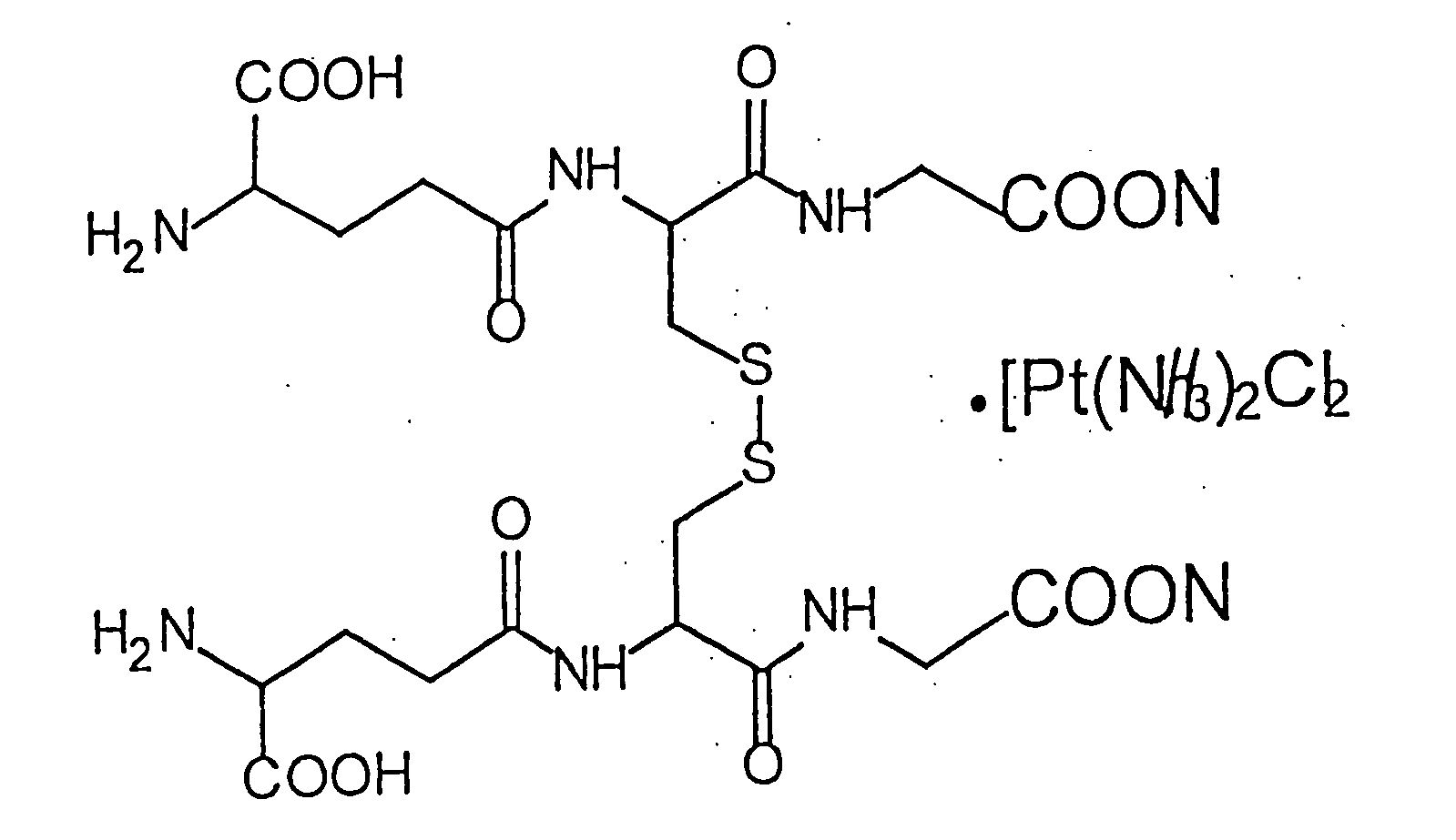Methods for production of the oxidized glutathione composite with cis-diamminedichloroplatinum and pharmaceutical compositions based thereof regulating metabolism, proliferation, differentiation and apoptotic mechanisms for normal and transformed cells
a technology of oxidized glutathione and cis-diamminedichloroplatinum, which is applied in the field of medicine, can solve the problems of reducing the effect of pharmaceuticals, affecting the reaction rate, and being foreign to an organism at their very natur
- Summary
- Abstract
- Description
- Claims
- Application Information
AI Technical Summary
Benefits of technology
Problems solved by technology
Method used
Image
Examples
example 1
Synthesis of bis-(L-phenylalanyl-γ-L-glutamyl)-L-cysteinyl-bis-glycine disodium salt
(I.) General Drug Characteristics. 1. Name: bis-(L-phenylalanyl-γ-L-glutamyl)-L-cysteinyl-bis-glycine disodium salt, composite with cis-diamminedichlorplatinum. 2. Structural formula—see FIG. 8. 3. Gross-formula: C38H48N8O14Na2S2.[Pt(NH3)2Cl2] 4. Molecular weight: 950,94 on C38H48N8O14Na2S2 with Pt content 0,033%. 5. Appearance: white odorless powder. 6. Solubility: soluble in water, 0.9% isotonic solution of sodium chloride for injections; insoluble in 95% alcohol, chloroform, ether and other organic dissolvents. 7. Solution transparency and color: 0.05 g of the drug solution in 10 ml of water is transparent and colorless. 8. pH of 0.1% solution: 5.75 (potentiometry). 9. Authenticity: a) amino-acid analysis (6 n HCl, 110° C., 20 hrs.), (error margin 20%, for cysteine—35%), in correspondence: glycine—2.00; glutamic acid—1.92; cysteine—1.81; phenylalanine—2.04.
b) NMR(1H)-spectroscopy, acc...
example 2
Synthesis of bis-(γ-L-glutamyl)-L-cysteinyl-bis-glycine lithium salt
(I.) General Drug Characteristics. 1. Name: bis-(γ-L-glutamyl)-L-cystinyl-bis-glycine dilithium salt with cis-diamminedichloroplatinum. 2. Structural formula—see FIG. 9. 3. Gross-formula: C20H30N6O12Li2S2.[Pt(NH3)2Cl2] 4. Molecular weight: 624.49 on C20H30N6O12Li2S2 with Pt content 0,032% 5. Appearance: white odorless powder. 6. Solubility: soluble in water, 0.9% isotonic solution of sodium chloride for injections; insoluble in 95% alcohol, chloroform, ether and other organic dissolvents. 7. Solution transparency and color: 0.05 g of the drug solution in 10 ml of water is transparent and colorless. 8. pH of 0.1% solution: 5.0-6.0 (potentiometry). 9. Authenticity: a) amino-acid analysis (6 n HCl, 110° C., 20 hrs.) in correspondence: glycine—2.0 (2.0); glutamic acid—1.9 (2.0); cysteine—1.7 (2.0). b) NMR(1H)-spectroscopy, in correspondence: CH2(δ 2.05, 2.40, 3.00, 3.80); CH (δ 3.72, 4.65). c) HPLC correspo...
example 3
Pharmacokinetics and Metabolism of GSSG.Pt and GSSG in Blood Serum and Tissues after Intravenous Introduction
The time-concentration GSSG curves and activity changes for enzymes participating at the GSSG metabolism after the GSSG Pt and GSSG intravenous introduction in different doses were studied. The variation of the oxidized glutathione concentration was evaluated in animal blood serum, liver, kidneys, spleen and lymphocytes during 60 min. after the single GSSG.Pt and GSSG intravenous introduction in doses 2 mg / kg and 20 mg / kg of body weight. In addition, the activity variation of the enzymes participating in GSSG metabolism was evaluated (glutathione reductase, glutathione-peroxidase, glutathione-S-transferase,γ-glutamyl-transpeptidase).
The study was performed at male CBA mice (standard body weight—180 to 200 g). Five groups of animals (with no less than 15 mice in each) were formed. The group description is represented below.
Control Groups:
#1—intact animals receiving a s...
PUM
| Property | Measurement | Unit |
|---|---|---|
| weight | aaaaa | aaaaa |
| concentration | aaaaa | aaaaa |
| volume | aaaaa | aaaaa |
Abstract
Description
Claims
Application Information
 Login to View More
Login to View More - R&D
- Intellectual Property
- Life Sciences
- Materials
- Tech Scout
- Unparalleled Data Quality
- Higher Quality Content
- 60% Fewer Hallucinations
Browse by: Latest US Patents, China's latest patents, Technical Efficacy Thesaurus, Application Domain, Technology Topic, Popular Technical Reports.
© 2025 PatSnap. All rights reserved.Legal|Privacy policy|Modern Slavery Act Transparency Statement|Sitemap|About US| Contact US: help@patsnap.com



